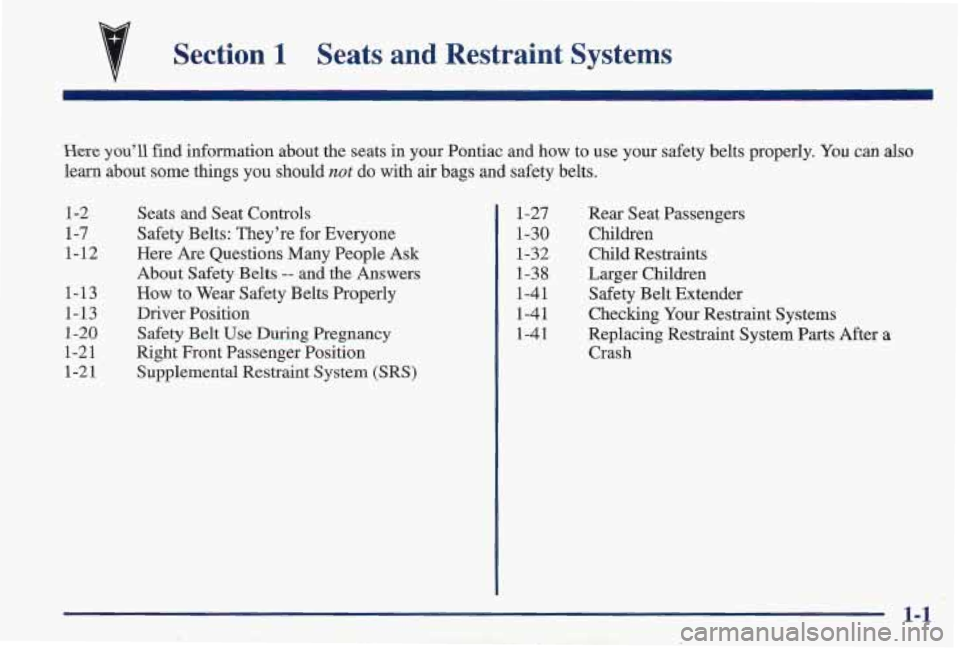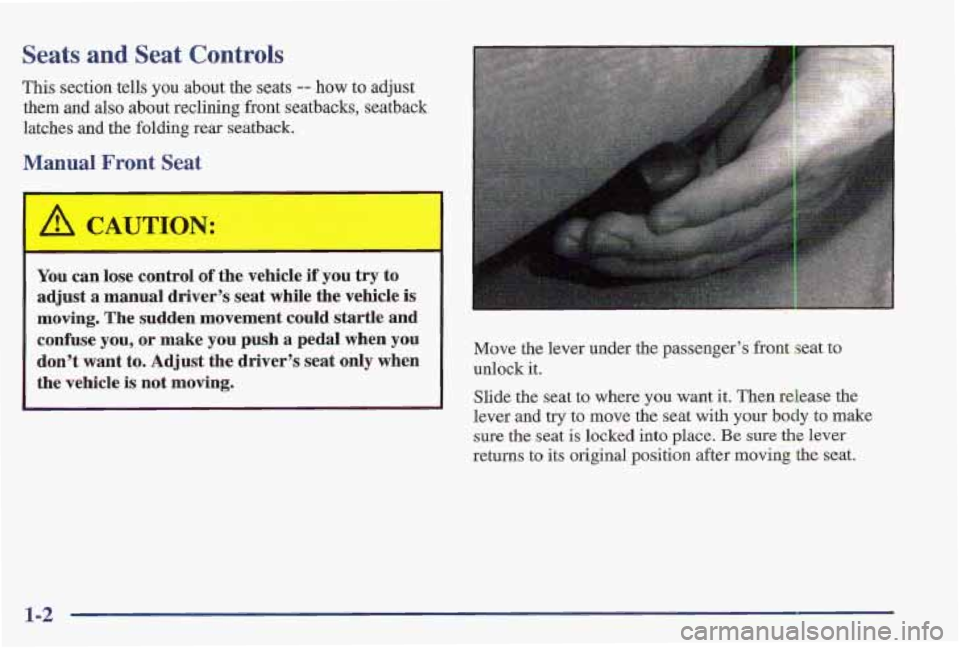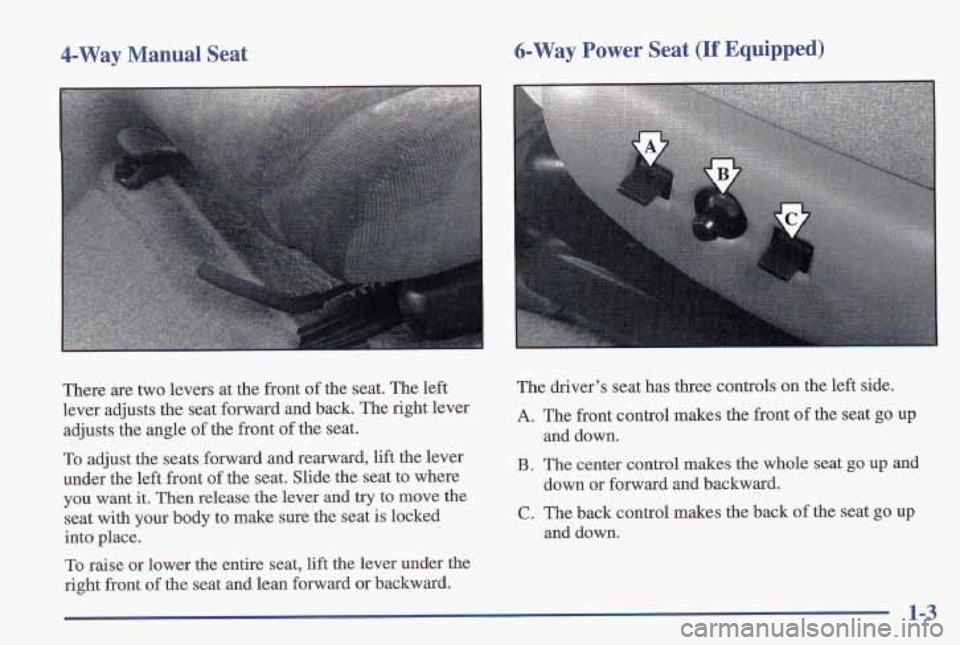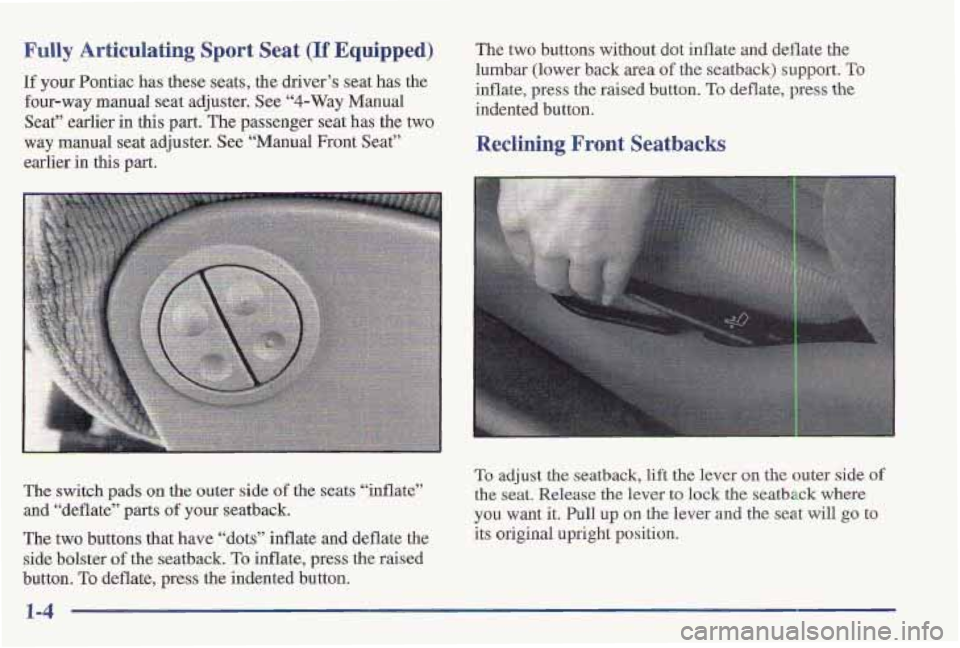seats PONTIAC FIREBIRD 1997 Owners Manual
[x] Cancel search | Manufacturer: PONTIAC, Model Year: 1997, Model line: FIREBIRD, Model: PONTIAC FIREBIRD 1997Pages: 410, PDF Size: 19.2 MB
Page 2 of 410

The 1997 Pontiac Firebird Owner’s Manual
1-1
2-1
3-1
4-1
5-1
6-1
7-1
8-1
Seats and Restraint Systems
This section tells you how to use your seats and safety belts\
properly. It also explains the “SRS” system.
Features and Controls
This section explains how to start and operate your Pontiac.
Comfort Controls and Audio Systems
This section tells you how to adjust the ventilation and comfo\
rt controls and how to operate your audio system.
Your Driving and the Road
Here you’ll find helpful information and tips about the road\
and how to drive under different conditions.
Problems on the Road
This section tells what to do if you have a problem while driving, such as a flat tire or overheated engine, etc.
Service and Appearance Care
Here the manual tells you how to keep your Pontiac running properly and\
looking good.
Maintenance Schedule
This section tells you when to perform vehicle maintenance and \
what fluids and lubricants to use.
Customer Assistance Information
This section tells you how to contact Pontiac for assistance a\
nd how to get service and owner publications.
It also gives you information
on “Reporting Safety Defects” on page 8-10.
9-1 Index
Here’s an alphabetical listing of almost every subject in this manual. You can use it to quickly find
something
you want to read.
Page 8 of 410

v Section 1 Seats and Restraint Systems
Here you’ll find information about the seats in your Pontiac and how to use your safety belts properly. You can also
learn about some things you should not do with air bags and safety belts.
1-2
1-7
1-12
1-13
1-13
1-20
1-21
1-21
Seats and Seat Controls
Safety Belts: They’re for Everyone
Here Are Questions Many People
Ask
About Safety Belts -- and the Answers
How to Wear Safety Belts Properly
Driver Position
Safety Belt Use During Pregnancy
Right Front Passenger Position
Supplemental Restraint System (SRS) 1-27 Rear Seat Passengers
1-30 Children
1-32 Child Restraints 1-38 Larger Children
1-41 Safety Belt Extender
1-41 Checking Your Restraint Systems
1-41 Replacing Restraint System Parts After a
Crash
Page 9 of 410

Seats and Seat Controls
This section tells you about the seats -- how to adjust
them and also about reclining front s’eatbacks, seatback
latches and the folding rear seatback.
M-rual Front +at
You can lose control of the vehicle if you try to
adjust a manual driver’s seat while the vehicle is
moving. The sudden movement could startle and
confuse you,
or make you push a pedal when you
don’t want to. Adjust the driver’s
seat only when
the vehicle is not moving,
Move the lever under the passenger’s front seat to
unlock it,
Slide the seat to where you want it. Then release the
lever and
try to move the seat with your body to make
sure the seat is locked into place. Be sure the lever
returns
to its original position after moving the seat.
Page 10 of 410

4-Way Manual Seat 6-Way Power Seat (If Equipped)
There are two levers at the front of the seat. The left
lever adjusts the seat forward and back. The right lever
adjusts the angle of the front
of the seat.
To adjust the seats forward and rearward, lift the lever
under
the left front of the seat. Slide the seat to where
you want it. Then release the lever and try to move the
seat with your body to
make sure the seat is locked
into place.
To raise or lower the entire seat, lift the lever under the
right front
of the seat and lean forward or backward. The
driver’s seat has three controls on the left
side.
A. The front control makes the front of the seat go UP
and down.
B. The center control makes the whole seat go up and
down or forward and backward.
C. The back control makes the back of the seat go up
and down.
1-3
Page 11 of 410

Fully Articulating Sport Seat (If Equipped)
If your Pontiac has these seats, the driver’s seat has the
four-way manual seat adjuster. See
“4-Way Manual
Seat” earlier in this
part. The passenger seat has the two
way manual seat adjuster. See “Manual Front Seat”
earlier in this part. The
two buttons without dot inflate
and deflate the
lumbar (lower back area
of the seatback) support. To
inflate, press the raised button. To deflate, press the
indented button.
Reclining Front Seatbacks
I
The switch pads on the outer side of the seats “inflate”
and “deflate”
parts of your seatback.
The two buttons that have
“dots” inflate and deflate the
side bolster
of the seatback. To inflate, press the raised
button.
To deflate, press the indented button.
To adjust the seatback, lift the lever on the outer side of
the seat. Release the lever to lock the seatback where
you want it. Pull up on the lever and the’seat will go to
its original upright position.
1-4
Page 12 of 410

If you have fully articulating sport seats, your recliner
lever looks like this.
But don’t have a seatback reclined if your vehicle is moving.
I
/r CAC JON:
Sitting in a reclined position when your vehicle is
in motion can
be dangerous. Even if you buckle
CAUTION: (Continued)
1-5
Page 15 of 410

I
It is extremely dangerous to ride in a cargo area,
inside or outside of a vehicle. In a collision,
people riding in these areas are more likely to
be
seriously injured or killed. Do not allow people to
ride in any area of your vehicle that is not
equipped with seats and safety belts, Be sure
everyone in your vehicle is in
a seat and using a
safety belt properly.
I comes on as a reminder to
buckle up.
(See “Safety
Belt Reminder Light” in
the Index.) In
most states and Canadian provinces, the law says to
I wear safety belts. Here’s why: They work.
You never know if you’ll be in a crash. If you do have a
crash, you don’t know if it will be a bad one.
A few crashes are mild, and some crashes can be so
serious that even buckled up a person wouldn’t survive.
But most crashes are in between. In many
of them,
people who buckle up can survive and sometimes walk
away. Without belts they could have been badly hurt
or killed.
After more
than 25 yt;ars of safety belts in vehicles,
the facts are clear. In most crashes buckling up does
matter
... a lot!
1-8
Page 20 of 410

How to Wear Safety Belts Properly
Adults
This part is only for people of adult size.
Be aware that there are special things to know about safety
belts and children. And there are different rules for smaller
children and babies.
If a child will be riding in your
Pontiac, see
the part of this manual called “Children.”
Follow
those rules for everyone’s protection.
First, you’ll want to know which restraint systems your
vehicle has.
We’ll start with the driver position.
Driver Position
This part describes the driver’s restraint system.
Lap-Shoulder Belt
The driver has a lap-shoulder belt. Here’s how to wear
it properly.
1. Close and lock the door.
2. Adjust the seat (to see how, see “Seats” in the Index)
so you can sit up straight.
3.
4.
Pick up the latch plate and pull the belt across you.
Don’t let it get twisted.
On convertible models, the shoulder belt may lock if
you pull the belt across you very quickly.
If this
happens, let the belt go back slightly to unlock
it.
Then pull the belt across you more slowly.
Push
the latch plate into the buckle until it clicks.
1-13
Page 34 of 410

Rear Seat Passengers
It’s very important for rear seat passengers to buckle up!
Accident statistics show that unbelted people in the rear
seat are hurt more often in crashes than those who are
wearing safety belts.
Rear passengers who aren’t safety belted can be thrown
out
of the vehicle in a crash. And they can strike others
in the vehicle who
are wearing safety belts.
n
Lap-Shoulder Belt
The rear seats have lap-shoulder belts. Here’s how to
wear one properly.
1. Pick up the latch plate and pull the belt across you.
Don’t let it get twisted.
On convertible models, the shoulder belt may lock if
you pull the belt across you very quickly.
If this
happens, let the belt
go back slightly to unlock it.
Then pull the belt across you more slowly.
2. Push the latch plate into the buckle until it clicks.
1-27
Page 107 of 410

Storage Compartments
Glove Box
To open the glove box, lift up on the lev'er. Use your
door key to lock and unlock it, The glove b'ox has a
lamp inside.
Front Console
To use the storage are'a, push the tab and pull up
on the front end of the console. There is a cupholder
on the console,
The console will also have
a storage area.
Cassette and Compact Disc Storage
If you have a compact disc player, the console can be
used for storing your compact discs.
Map Pocket (If Equipped)
Each door has a map pocket. There may also be a map
pocket on the back of the seats.
Close-Out Panel
The close-out panel can be closed for hidden storage in
the rear area of your vehicle.
To remove the 'close-out panel
1. Close the panel. If the close-out panel is not closed
and resting
on the trim panel, it cannot be removed.
2. Pull the panel toward you to unsnap it. Then slide the
close-out panel along the groove
in the trim panel.
Reverse the steps
to install the panel.
2-58